The Rockall and the Orphan Basins of the Southern North Atlantic Ocean: Determining Continuous Basins across Conjugate Margins
Abstract
:1. Introduction
2. Geological Setting
3. Basin Evolution
3.1. Rockall Basin
3.2. Orphan Basin
4. Previously Published Plate Reconstructions
5. Methodology
5.1. Data
5.2. Seismic Interpretation
5.3. 2D Modelling
5.4. 3D Modelling
6. Results
6.1. Orphan Basin
6.1.1. Seismic Interpretation
6.1.2. 2D Basin Modelling
6.2. Rockall Basin
6.2.1. Seismic Interpretation
6.2.2. 2D Basin Modelling
6.3. 3D Basin Modelling across the Margins
7. Discussion
7.1. Interpreted Jurassic Sedimentary Rocks (or Lack Thereof)
7.2. Sedimentary Layer Thickness
7.3. Amount of Extension
7.4. Continental Crustal Thickness
7.5. 3D Geological Models for the Newfoundland-Ireland Conjugate Margins
7.6. Evolutionary History of the Newfoundland-Ireland Conjugate Margins
8. Conclusions
Author Contributions
Funding
Acknowledgments
Conflicts of Interest
References
- Chian, D.; Reid, I.D.; Jackson, H.R. Crustal structure beneath Orphan Basin and implications for nonvolcanic continental rifting. J. Geophys. Res. Solid Earth 2001, 106, 10923–10940. [Google Scholar] [CrossRef]
- Enachescu, M.; Meyer, K.; Hogg, J. East Orphan Basin: Structural setting and evolution with seismic and potential fields arguments. In Proceedings of the CSEG Annual Convention, Calgary, AB, Canada, 10–13 May 2004; p. 4. [Google Scholar]
- Lau, K.W.H.; Watremez, L.; Louden, K.E.; Nedimovíć, M.R. Structure of thinned continental crust across the Orphan Basin from a dense wide-angle seismic profile and gravity data. Geophys. J. Int. 2015, 202, 1969–1992. [Google Scholar] [CrossRef]
- Shannon, P.M. The development of Irish offshore sedimentary basins. J. Geol. Soc. London. 1991, 148, 181–189. [Google Scholar] [CrossRef]
- O’Reilly, B.M.; Hauser, F.; Jacob, A.W.B.; Shannon, P.M. The lithosphere below the Rockall Trough: Wide-angle seismic evidence for extensive serpentinisation. Tectonophysics 1996, 255, 1–23. [Google Scholar] [CrossRef]
- Hopper, J.R.; Funck, T.; Tucholke, B.E.; Louden, K.E.; Holbrook, W.S.; Larsen, H.C. A deep seismic investigation of the Flemish Cap margin: Implications for the origin of deep reflectivity and evidence for asymmetric break-up between Newfoundland and Iberia. Geophys. J. Int. 2006, 164, 501–515. [Google Scholar] [CrossRef] [Green Version]
- Peace, A.L.; Welford, J.K. “Conjugate margins?”–An oversimplification of the complex southern North Atlantic rift and spreading system? Interpretation 2020, 8, 1–54. [Google Scholar] [CrossRef] [Green Version]
- Yang, P.; Welford, J.K.; Peace, A.L.; Hobbs, R. Investigating the Goban Spur rifted continental margin, off shore Ireland, through integration of new seismic reflection and potential field data. Tectonophysics 2020, 777, 228364. [Google Scholar] [CrossRef]
- Tucholke, B.E.; Austin, J.A., Jr.; Uchupi, E. Crustal Structure and Rift-Drift Evolution of the Newfoundland Basin: Chapter 16: North American Margins. In Extensional Tectonics and Stratigraphy of the North Atlantic Margins: Introduction; Tankard, A.J., Balkwill, H.R., Eds.; AAPG: Tulsa, Ok, USA, 1989. [Google Scholar]
- Lundin, E.R.; Doré, A.G. Hyperextension, serpentinization, and weakening: A new paradigm for rifted margin compressional deformation. Geology 2011, 39, 347–350. [Google Scholar] [CrossRef]
- Watt, W. The coast-parallel dike swarm of southwest Greenland in relation to the opening of the Labrador Sea. Can. J. Earth Sci. 1969, 6, 1320–1321. [Google Scholar] [CrossRef]
- Chian, D.; Keen, C.; Reid, I.; Louden, K.E. Evolution of nonvolcanic rifted margins: New results from the conjugate margins of the Labrador Sea. Geology 1995, 23, 589–592. [Google Scholar] [CrossRef]
- Larsen, L.M.; Heaman, L.M.; Creaser, R.A.; Duncan, R.A.; Frei, R.; Hutchison, M. Tectonomagmatic events during stretching and basin formation in the Labrador Sea and Davis Strait: Evidence from age and composition of Mesozoic to Palaeogene dyke swarms in West Greeland. J. Geol. Soc. Lond. 2009, 166, 999–1012. [Google Scholar] [CrossRef]
- Naylor, D.; Shannon, P.M. The structural framework of the Irish Atlantic Margin. In Proceedings of the Petroleum Geology: North-West Europe and Global Perspectives, Proceedings of the 6th Petroleum Geology Conference, London, UK, 6–9 October 2003; pp. 1009–1021. [Google Scholar]
- Welford, J.K.; Shannon, P.M.; O’Reilly, B.M.; Hall, J.; Reilly, B.M.O.; Hall, J. Comparison of lithosphere structure across the Orphan Basin – Flemish Cap and Irish Atlantic conjugate continental margins from constrained 3D gravity inversions. J. Geol. Soc. Lond. 2012, 169, 405–420. [Google Scholar] [CrossRef]
- Srivastava, S.P.; Roest, W.R.; Kovacs, L.C.; Oakey, G.; Lévesque, S.; Verhoef, J.; Macnab, R. Motion of Iberia since the Late Jurassic: Results from detailed aeromagnetic measurements in the Newfoundland Basin. Tectonophysics 1990, 184, 229–260. [Google Scholar] [CrossRef]
- Srivastava, S.P.; Verhoef, J. Evolution of Mesozoic sedimentary basins around the North Central Atlantic: A preliminary plate kinematic solution. Geol. Soc. Lond. Spec. Publ. 1992, 62, 397–420. [Google Scholar] [CrossRef]
- Knott, S.D.; Burchell, M.T.; Jolley, E.J.; Fraser, A.J. Mesozoic to Cenozoic Plate Reconstructions of the North Atlantic and Hydrocarbon Plays of the Atlantic Margins; Geological Society, London, Petroleum Geology Conference series; Geological Society of London: London, UK, 1993; Volume 4, pp. 953–974. [Google Scholar]
- Louden, K.E.; Tucholke, B.E.; Oakey, G.N. Regional anomalies of sediment thickness, basement depth and isostatic crustal thickness in the North Atlantic Ocean. Earth Planet. Sci. Lett. 2004, 224, 193–211. [Google Scholar] [CrossRef]
- Enachescu, M.E. Structural Setting and Petroleum Potential of the Orphan Basin, offshore Newfoundland and Labrador. Can. Soc. Explor. Geophys. Rec. 2006, 31, 5–13. [Google Scholar]
- Gouiza, M.; Hall, J.; Welford, J.K. Tectono-stratigraphic evolution and crustal architecture of the Orphan Basin during North Atlantic rifting. Int. J. Earth Sci. 2017, 106, 917–937. [Google Scholar] [CrossRef] [Green Version]
- Nirrengarten, M.; Manatschal, G.; Tugend, J.; Kusznir, N.; Sauter, D. Kinematic evolution of the southern North Atlantic: Implications for the formation of hyper-extended rift systems. Tectonics 2018, 37, 89–118. [Google Scholar] [CrossRef] [Green Version]
- Peace, A.L.; Welford, J.K.; Ball, P.J.; Nirrengarten, M. Deformable plate tectonic models of the southern North Atlantic. J. Geodyn. 2019, 128, 11–37. [Google Scholar] [CrossRef]
- Skogseid, J. The Orphan Basin—A key to understanding the kinematic linkage between North and NE Atlantic Mesozoic rifting. In Proceedings of the II Central & North Atlantic Conjugate Margins Conference, Lisbon, Portugal, 29 September–1 October 2010; Volume II, pp. 13–23. [Google Scholar]
- Sandoval, L.; Welford, J.K.; MacMahon, H.; Peace, A.L. Determining continuous basins across conjugate margins: The East Orphan, Porcupine, and Galicia Interior basins of the southern North Atlantic Ocean. Mar. Pet. Geol. 2019, 110, 138–161. [Google Scholar] [CrossRef]
- Morewood, N.C.C.; Mackenzie, G.D.D.; Shannon, P.M.M.; Reilly, B.M.O.; O’Reilly, B.M.; Readman, P.W.; Makris, J. The crustal structure and regional development of the Irish Atlantic margin region. In Proceedings of the Petroleum Geology: North-West Europeand Global Perspectives—Proceedings of the 6th Petroleum Geology Conference, London, UK, 6–9 October 2003; Volume 6, pp. 1023–1033. [Google Scholar]
- Keen, C.E.; Barrett, D.L. Thinned and subsided continental crust on the rifted margin of eastern Canada: Crustal structure, thermal evolution and subsidence history. Geophys. J. Int. 1981, 65, 443–465. [Google Scholar] [CrossRef] [Green Version]
- Musgrove, F.W.; Mitchener, B. Analysis of the pre-Tertiary rifting history of the Rockall Trough. Pet. Geosci. 1996, 2, 353–360. [Google Scholar] [CrossRef]
- Shannon, P.M.; Jacob, A.W.B.; O’Reilly, B.M.; Hauser, F.; Readman, P.W.; Makris, J. Structural setting, geological development and basin modelling in the Rockall Trough. Pet. Geol. Northwest Eur. Proc. 5th Conf. Pet. Geol. Northwest Eur. 1999, 5, 421–431. [Google Scholar] [CrossRef]
- Peace, A.; McCaffrey, K.; Imber, J.; van Hunen, J.; Hobbs, R.W.; Wilson, R. The role of pre-existing structures during continental breakup and transform system development in the Davis Strait, offshore West Greenland. Basin Res. 2018, 30, 373–394. [Google Scholar] [CrossRef] [Green Version]
- Foulger, G.R.; Doré, T.; Emeleus, C.H.; Franke, D.; Geoffroy, L.; Gernigon, L.; Hey, R.; Holdsworth, R.E.; Hole, M.; Höskuldsson, Á.; et al. The Iceland Microcontinent and a continental Greenland-Iceland-Faroe Ridge. Earth Sci. Rev. 2019, 102926. [Google Scholar] [CrossRef]
- Foulger, G.R.; Schiffer, C.; Peace, A.L. A new paradigm for the North Atlantic Realm. Earth Sci. Rev. 2020, 103038, In press. [Google Scholar] [CrossRef]
- Schiffer, C.; Doré, A.G.; Foulger, G.R.; Franke, D.; Geoffroy, L.; Gernigon, L.; Holdsworth, R.E.; Kusznir, N.; Lundin, E.; McCaffrey, K.J.; et al. Structural inheritance in the North Atlantic. Earth Sci. Rev. 2019, 102975. [Google Scholar] [CrossRef]
- Peace, A.; Phethean, J.; Franke, D.; Foulger, G.R.; Schiffer, C.; Welford, J.K.; McHone, G.; Rocchi, S.; Schnabel, M.; Doré, A. A review of Pangaea dispersal and Large Igneous Provinces – In search of a causative mechanism. Earth Sci. Rev. 2019, 196, 102865. [Google Scholar] [CrossRef]
- Doré, A.G.; Lundin, E.R.; Jensen, L.N.; Birkeland, Ø.; Eliassen, P.E.; Fichler, C. Principal tectonic events in the evolution of the northwest European Atlantic margin. Pet. Geol. Northwest Eur. Proc. 5th Conf. 1999, 5, 41–61. [Google Scholar] [CrossRef]
- Hitchen, K. The geology of the UK Hatton-Rockall margin. Mar. Pet. Geol. 2004, 21, 993–1012. [Google Scholar] [CrossRef]
- Morewood, N.C.; Shannon, P.M.; Mackenzie, G.D. Seismic stratigraphy of the southern Rockall Basin: A comparison between wide-angle seismic and normal incidence reflection data. Mar. Pet. Geol. 2004, 21, 1149–1163. [Google Scholar] [CrossRef]
- Magee, C.; Jackson, C.A.L.; Schofield, N. Diachronous sub-volcanic intrusion along deep-water margins: Insights from the Irish Rockall Basin. Basin Res. 2014, 26, 85–105. [Google Scholar] [CrossRef]
- Stoker, M.S.; Stewart, M.A.; Shannon, P.M.; Bjerager, M.; Nielsen, T.; Blischke, B.O.; Hjelstuen, B.O.; Gaina, C.; McDermott, K.; Olavsdottir, J. An overview of the Upper Palaeozoic-Mesozoic stratigraphy of the NE Atlantic region. Geol. Soc. Lond. Spec. Publ. 2016, 447, 11–68. [Google Scholar] [CrossRef] [Green Version]
- Gradstein, F.M.; Ogg, J.G.; Schmitz, M.D.; Ogg, G.M. The Geological Time Scale; Elsevier: Amsterdam, The Netherlands, 2012. [Google Scholar]
- Williams, H. Miogeoclines and suspect terranes of the Caledonian–Appalachian Orogen: Tectonic patterns in the North Atlantic region. Can. J. Earth Sci. 1984, 21, 887–901. [Google Scholar] [CrossRef]
- Williams, H. Geology of the Appalachian—Caledonian Orogen in Canada and Greenland; Geological Society of America: Boulder, CO, USA, 1995; ISBN 0813754518. [Google Scholar]
- Gouiza, M.; Hall, J.; Bertotti, G. Rifting and pre-rift lithosphere variability in the Orphan Basin, Newfoundland margin, Eastern Canada. Basin Res. 2015, 27, 367–386. [Google Scholar] [CrossRef]
- Chian, D.; Louden, K.E.; Reid, I. Crustal structure of the Labrador Sea conjugate margin and implications for the formation of nonvolcanic continental margins. J. Geophys. Res. 1995, 100, 24239. [Google Scholar] [CrossRef] [Green Version]
- Peace, A.L.; McCaffrey, K.J.W.; Imber, J.; Phethean, J.; Nowell, G.; Gerdes, K.; Dempsey, E. An evaluation of Mesozoic rift-related magmatism on the margins of the Labrador Sea: Implications for rifting and passive margin asymmetry. Geosphere 2016, 12, 1701–1724. [Google Scholar] [CrossRef] [Green Version]
- Matthews, K.J.; Maloney, K.T.; Zahirovic, S.; Williams, S.E.; Seton, M.; Müller, R.D. Global plate boundary evolution and kinematics since the late Paleozoic. Glob. Planet. Chang. 2016, 146, 226–250. [Google Scholar] [CrossRef]
- Müller, R.D.; Seton, M.; Zahirovic, S.; Williams, S.E.; Matthews, K.J.; Wright, N.M.; Shephard, G.E.; Maloney, K.T.; Barnett-Moore, N.; Hosseinpour, M.; et al. Ocean Basin Evolution and Global-Scale Plate Reorganization Events Since Pangea Breakup. Annu. Rev. Earth Planet. Sci. 2016, 44, 107–138. [Google Scholar] [CrossRef]
- Archer, S.G.; Bergman, S.C.; Iliffe, J.; Murphy, C.M.; Thornton, M. Palaeogene igneous rocks reveal new insights into the geodynamic evolution and petroleum potential of the Rockall Trough, NE Atlantic Margin. Basin Res. 2005, 17, 171–201. [Google Scholar] [CrossRef]
- O’Reilly, B.M.; Hauser, F.; Ravaut, C.; Shannon, P.M.; Readman, P.W. Crustal thinning, mantle exhumation and serpentinization in the Porcupine Basin, offshore Ireland: Evidence from wide-angle seismic data. J. Geol. Soc. Lond. 2006, 163, 775–787. [Google Scholar] [CrossRef]
- Sclater, J.G.; Christie, P.A.F. Continental stretching: An explanation of the post-Mid-Cretaceous subsidence of the Central North Sea Basin. J. Geophys. Res. Solid Earth 1980, 85, 3711–3739. [Google Scholar] [CrossRef]
- Mackenzie, G.D.; Shannon, P.M.; Jacob, A.W.B.; Morewood, N.C.; Makris, J.; Gaye, M.; Egloff, F. The velocity structure of the sediments in the southern Rockall Basin: Results from new wide-angle seismic modelling. Mar. Pet. Geol. 2002, 19, 989–1003. [Google Scholar] [CrossRef]
- Fossen, H. Structural Geology; Cambridge University Press: Cambridge, UK, 2016; ISBN 1316472957. [Google Scholar]
- Pérez-Gussinyé, M.; Reston, T.J. Rheological evolution during extension at nonvolcanic rifted margins: Onset of serpentinization and development of detachments leading to continental breakup. J. Geophys. Res. Solid Earth 2001, 106, 3961–3975. [Google Scholar] [CrossRef]
- Boyden, J.A.; Müller, R.D.; Gurnis, M.; Torsvik, T.H.; Clark, J.A.; Turner, M.; Ivey-Law, H.; Watson, R.J.; Cannon, J.S. Next-generation plate-tectonic reconstructions using GPlates. In Geoinformatics: Cyberinfrastructure for the Solid Earth Science; Keller, G.R., Baru, C., Eds.; Cambridge University Press: Cambridge, UK, 2011; pp. 95–114. [Google Scholar]
- Shannon, P.M.; Moore, J.G.; Jacob, A.W.B.; Makris, J. Cretaceous and Tertiary basin development west of Ireland; Geological Society, London, Petroleum Geology Conference series; Geological Society of London: London, UK, 1993; Volume 4, pp. 1057–1066. [Google Scholar]
- Shannon, P.M.; Murphy, N.; Ireland. Department of Marine and Natural Resources. Irish Rockall Basin region-a standard structural nomenclature system; Ireland. Department of the Marine and Natural Resources, 1999; ISBN 0707662893. [Google Scholar]
- Stoker, M.S.; Van Weering, T.C.E.; Svaerdborg, T. A mid-to late Cenozoic tectonostratigraphic framework for the Rockall Trough. Geol. Soc. Lond. Spec. Publ. 2001, 188, 411–438. [Google Scholar] [CrossRef]
- McDonnell, A.; Shannon, P.M. Comparative Tertiary stratigraphic evolution of the Porcupine and Rockall basins. Geol. Soc. London, Spec. Publ. 2001, 188, 323–344. [Google Scholar] [CrossRef]
- Driscoll, N.W.; Karner, G.D. Lower crustal extension across the Northern Carnarvon basin, Australia: Evidence for an eastward dipping detachment. J. Geophys. Res. Solid Earth 1998, 103, 4975–4991. [Google Scholar] [CrossRef]
- Sibuet, J.-C. New constraints on the formation of the non-volcanic continental Galicia–Flemish Cap conjugate margins. J. Geol. Soc. Lond. 1992, 149, 829–840. [Google Scholar] [CrossRef]
- Davis, M.; Kusznir, N.J. Depth-dependent lithospheric stretching at rifted continental margins. Proc. NSF Rift. Margins Theor. Inst. 2004, 136, 92–137. [Google Scholar]
- Reston, T.J. Polyphase faulting during the development of the west Galicia rifted margin. Earth Planet. Sci. Lett. 2005, 237, 561–576. [Google Scholar] [CrossRef]
- Kusznir, N.J.; Hunsdale, R.; Roberts, A.M.; Team, I. Norwegian margin depth-dependent stretching. In Proceedings of the Petroleum Geology: North-West Europe and Global Perspectives-Proceedings of the 6th Petroleum Geology Conference, London, UK, 6–9 October 2003; Dore, A.G., Vining, B.A., Eds.; pp. 767–783. [Google Scholar]
- Reston, T. Extension discrepancy of North Atlantic nonvolcanic rifted margins: Depth-dependent stretching or unrecognized faulting? Geology 2007, 35, 367–370. [Google Scholar] [CrossRef]
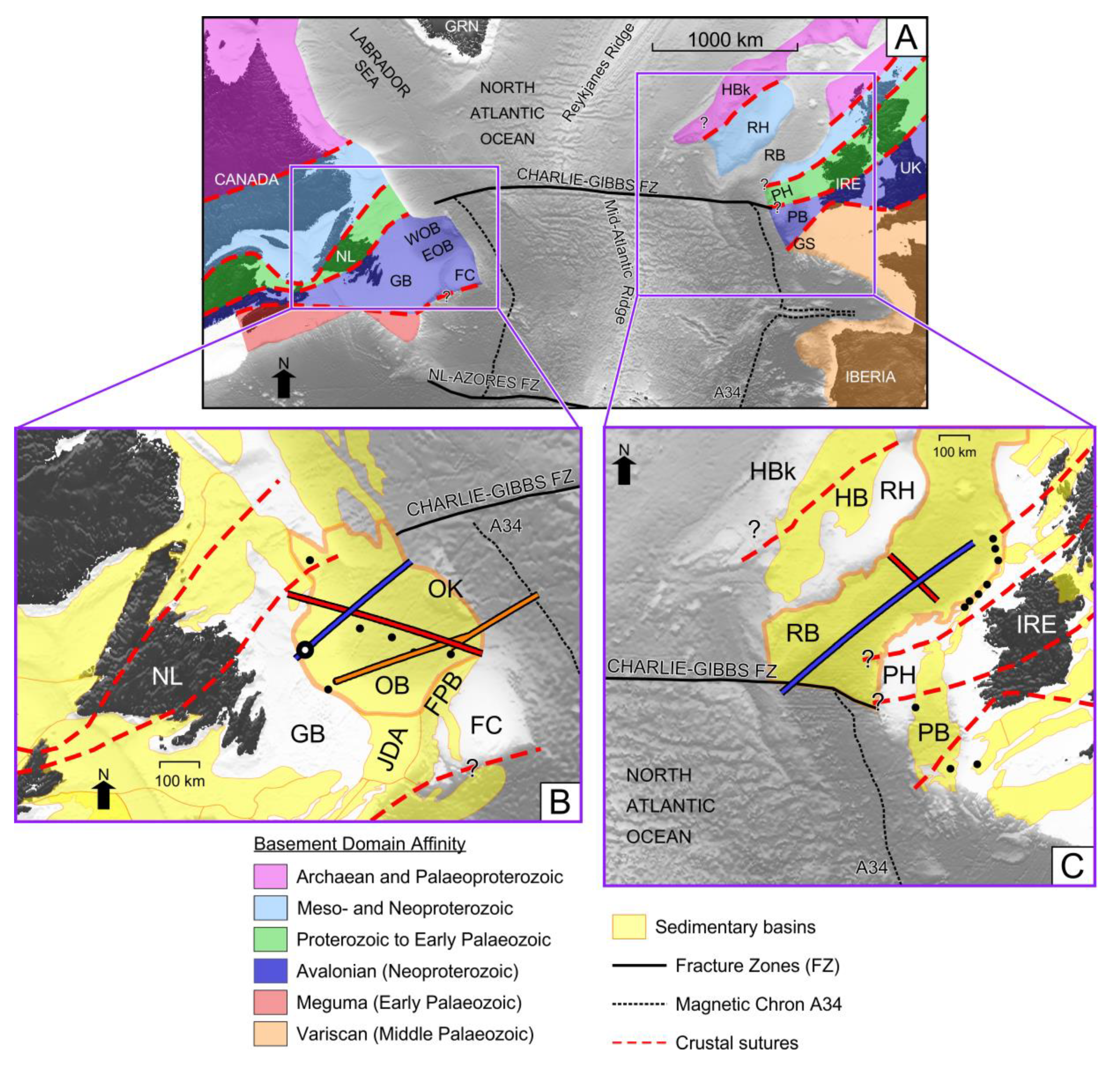
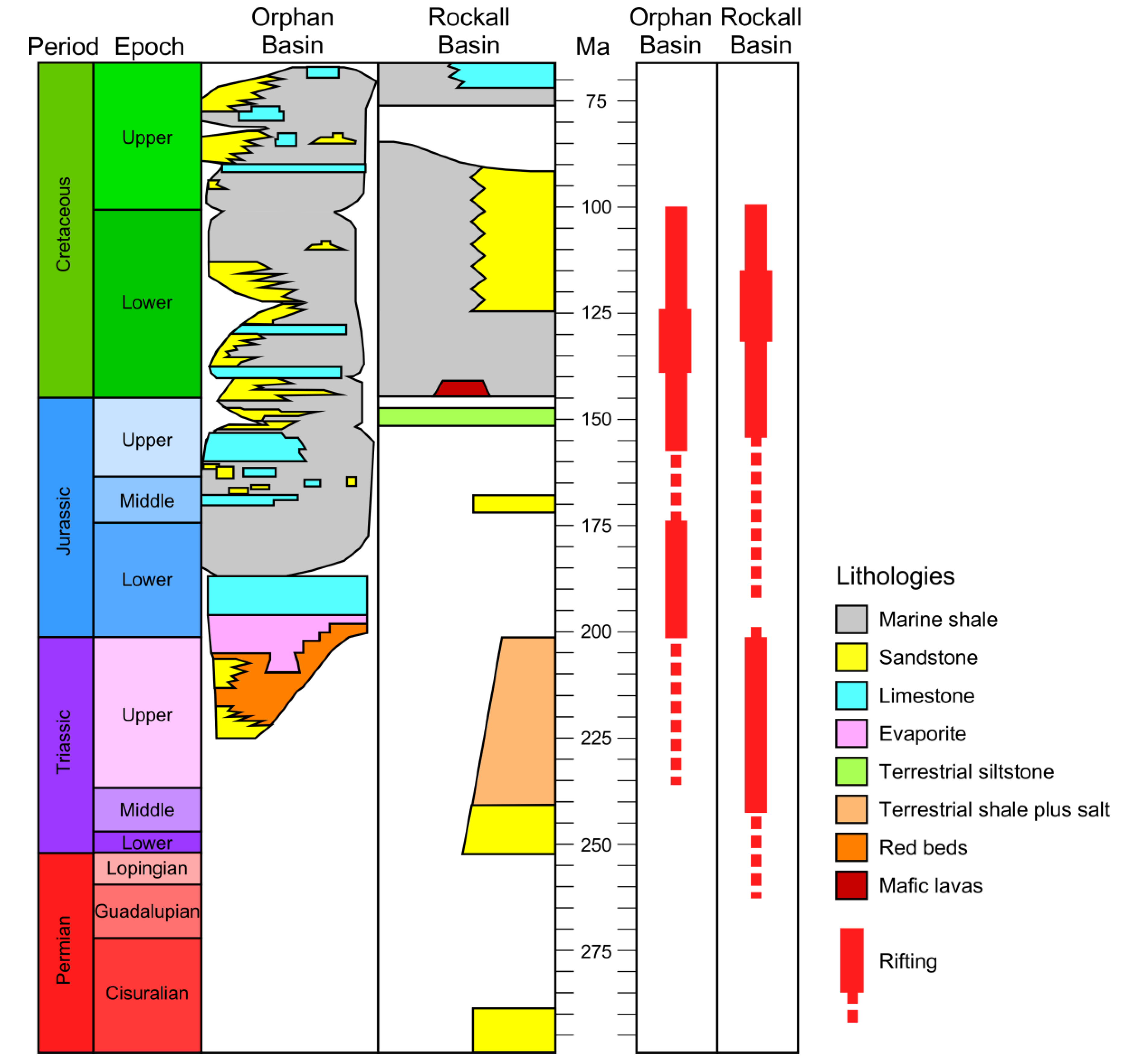
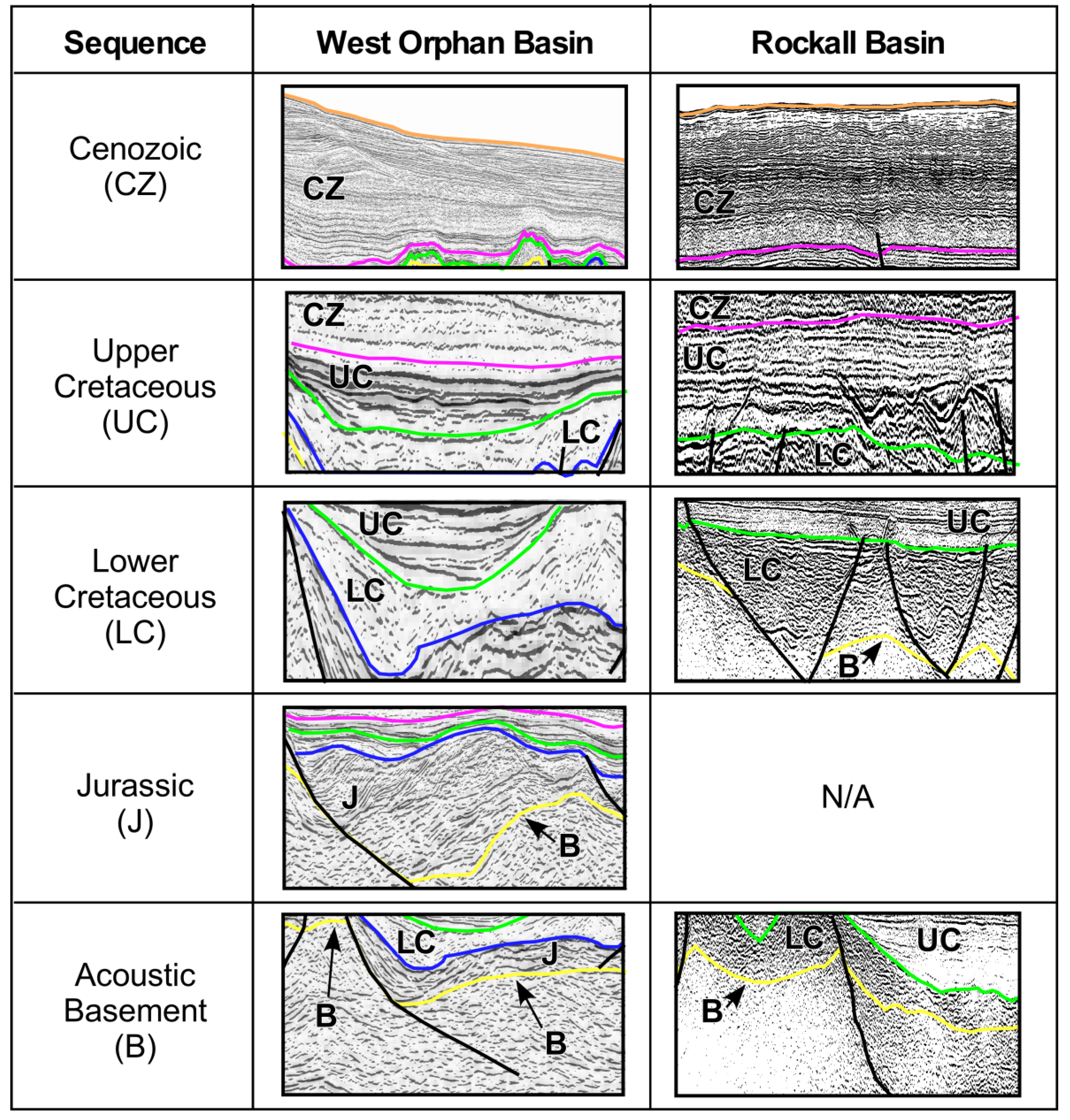
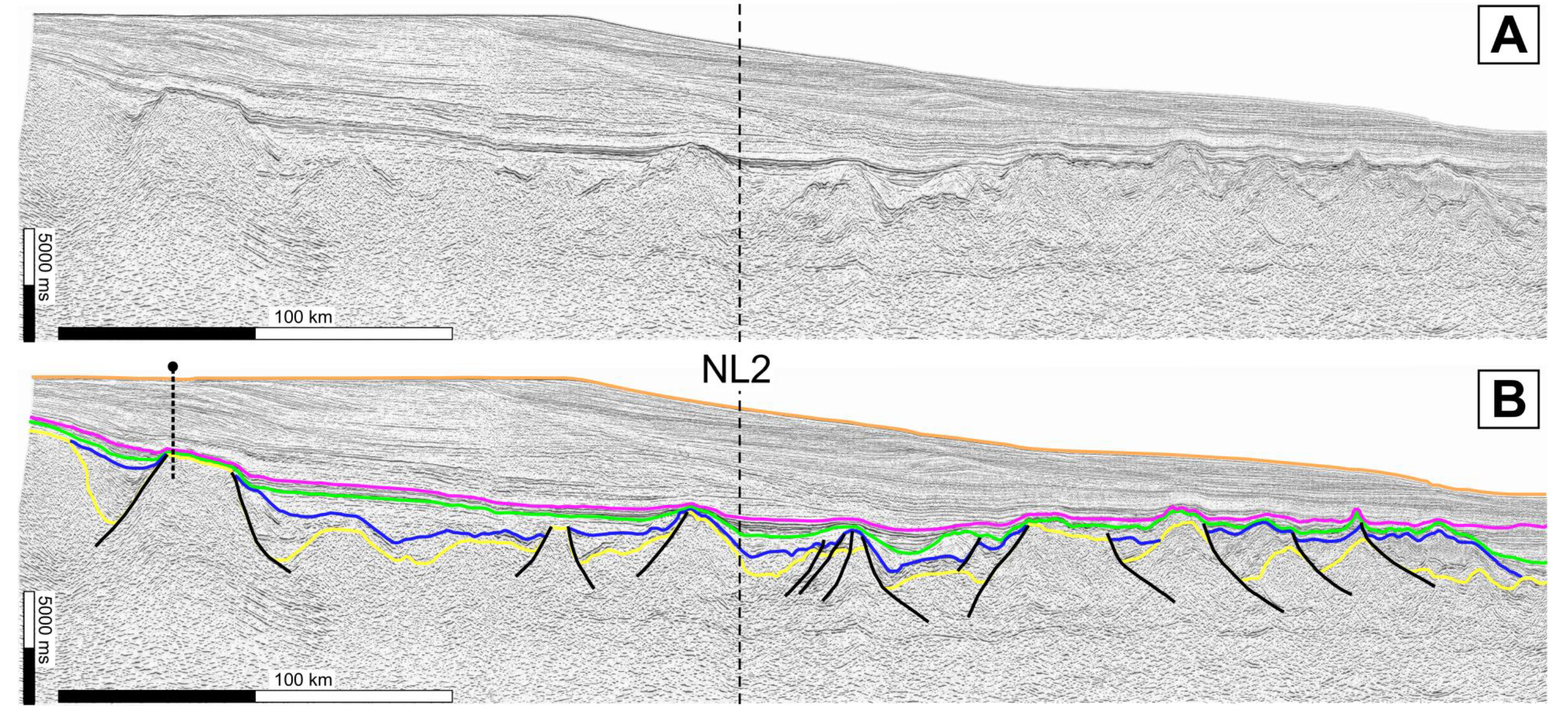

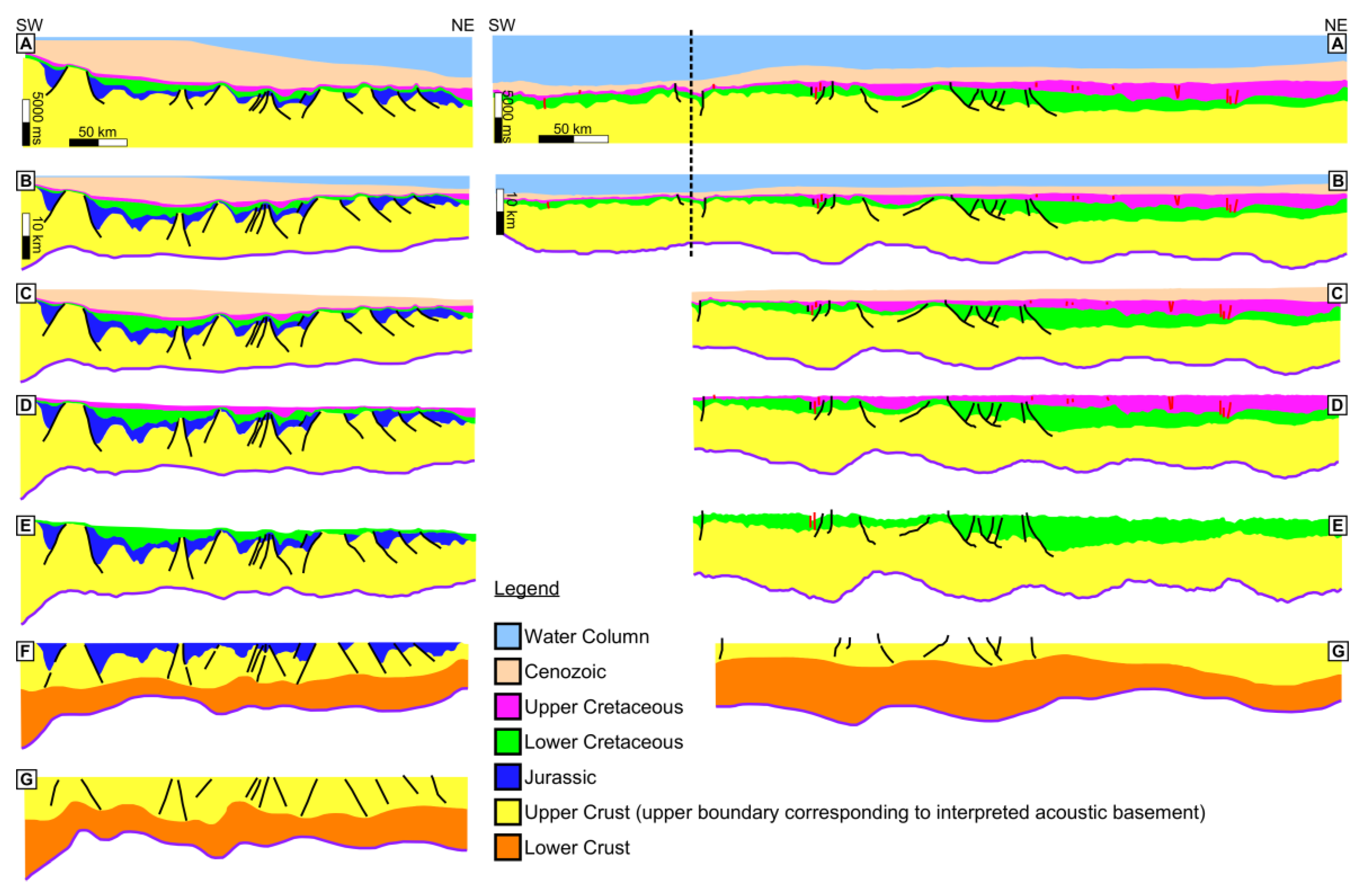
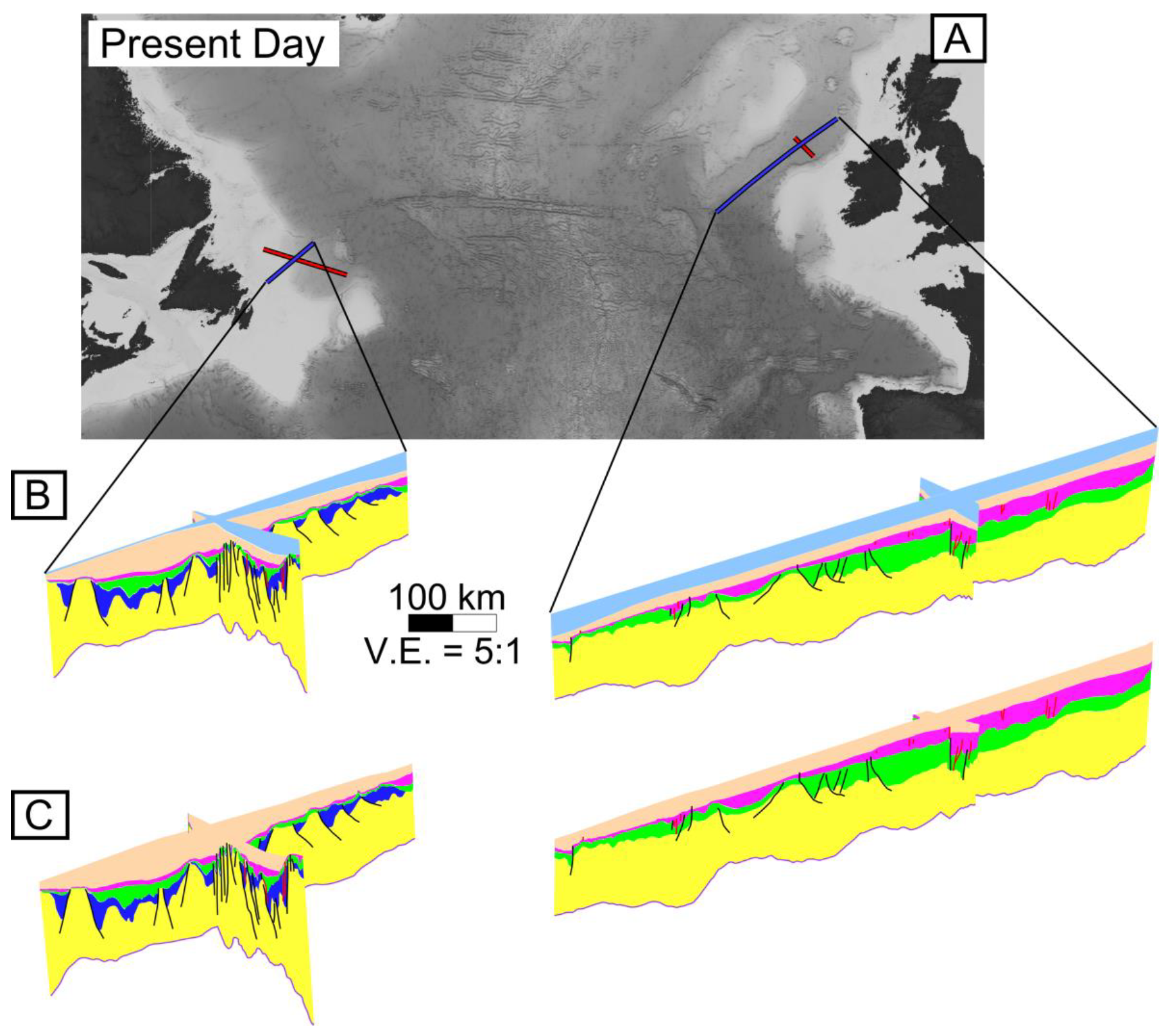
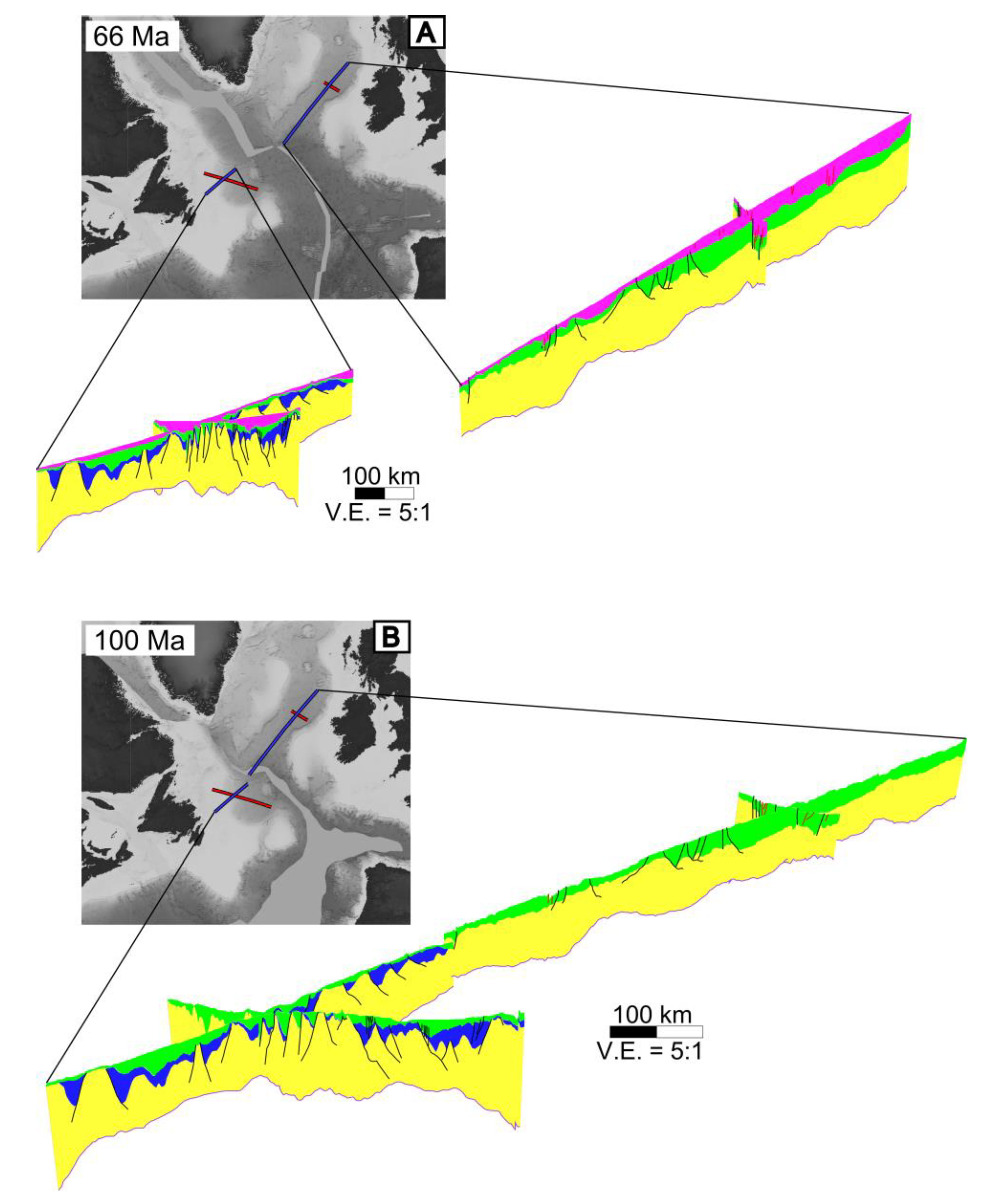
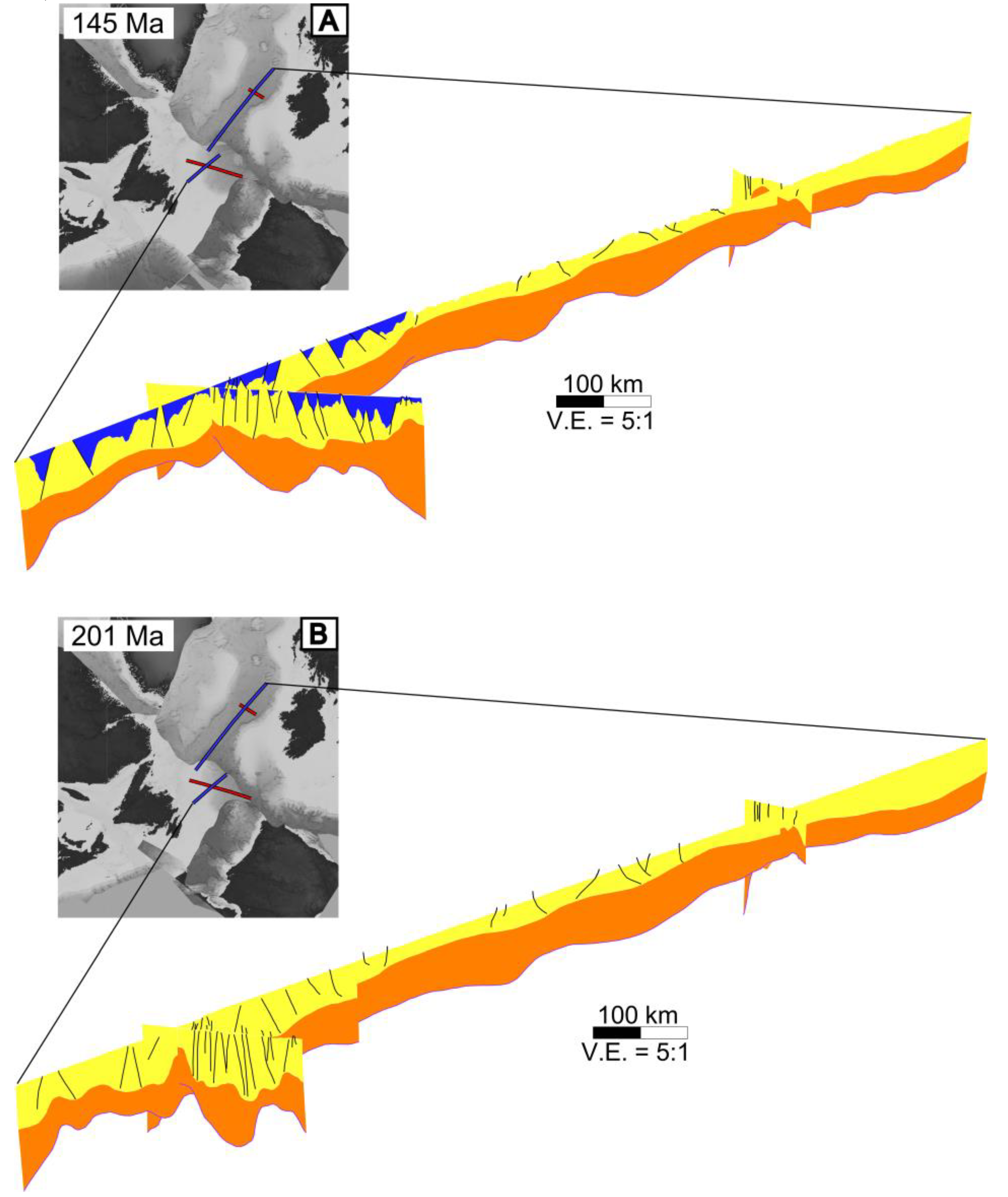
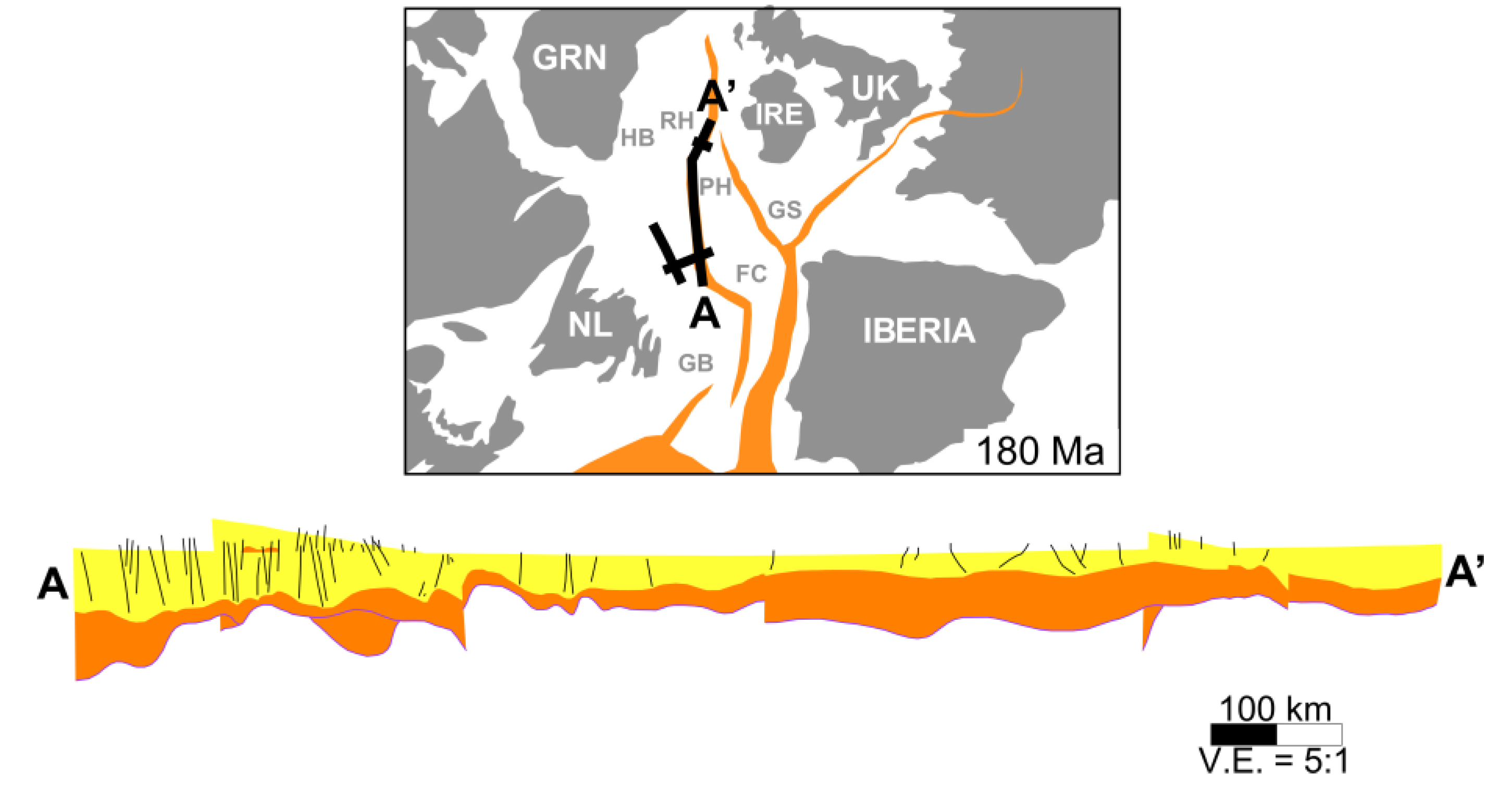
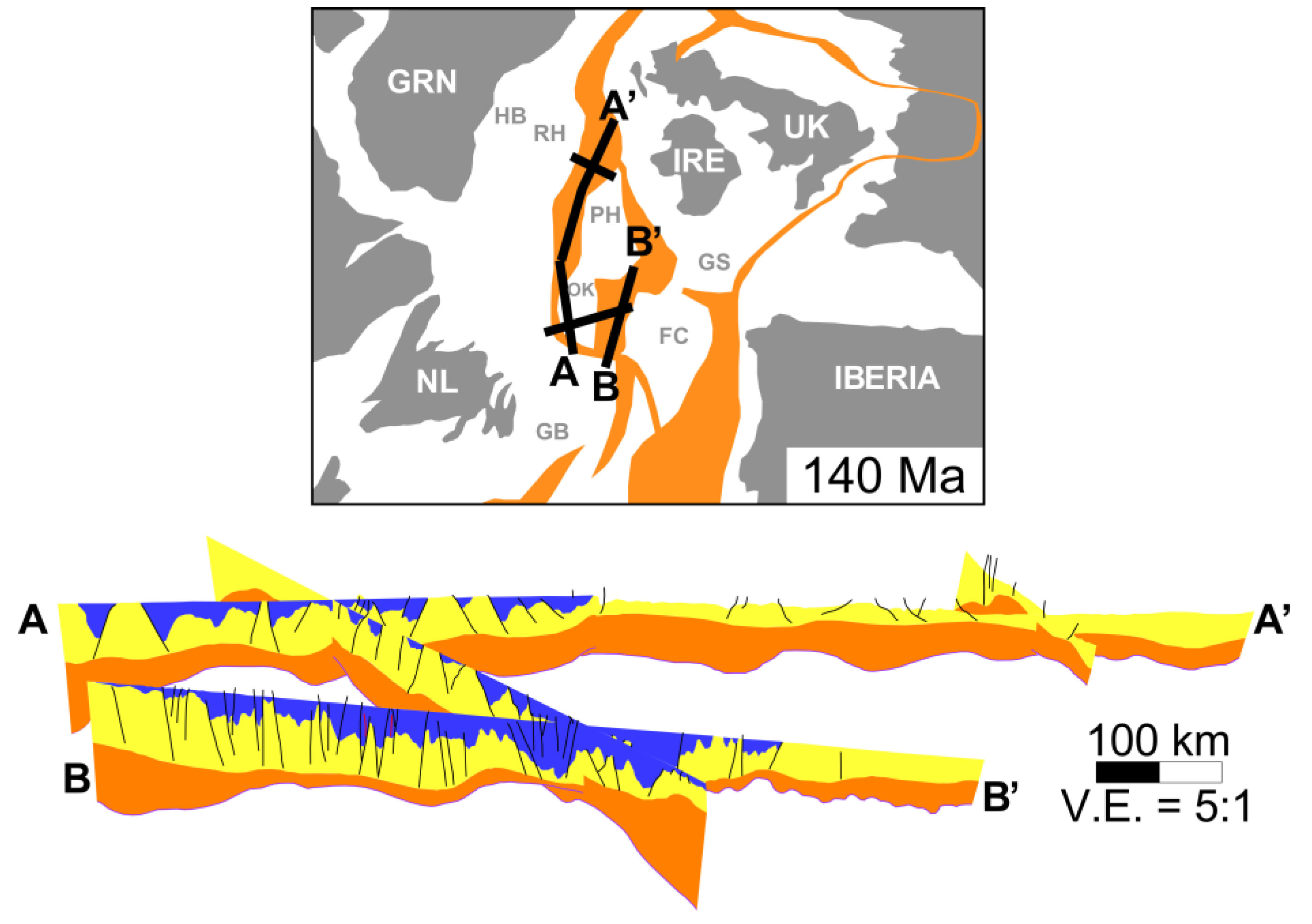
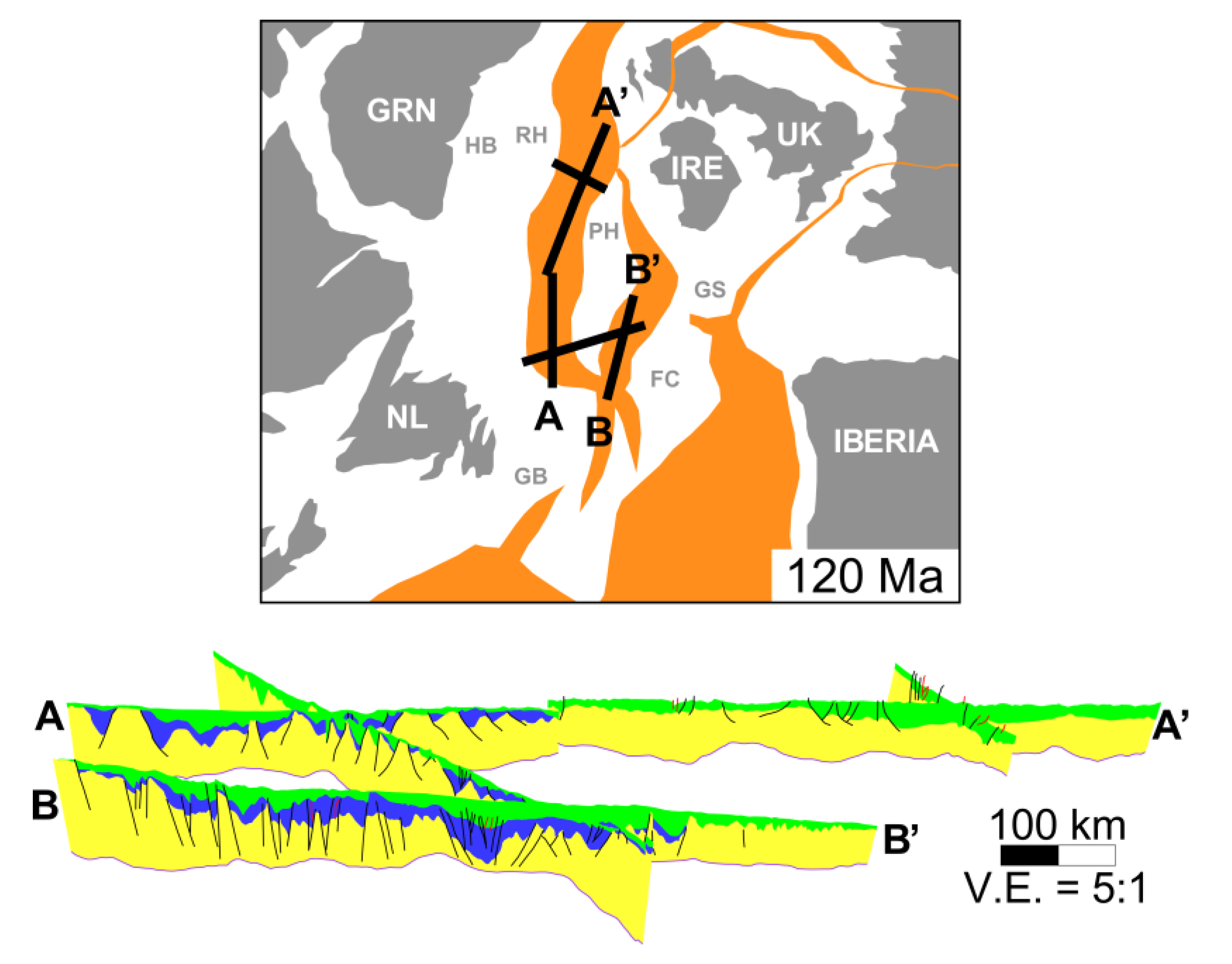
| Density (kg/m3) | Velocity for the Orphan Basin (m/s) | Velocity for the Rockall Basin (m/s) | Thickness of Layers in the Orphan Basin (m) | Thickness of Layers in the Rockall Basin (m) | |
|---|---|---|---|---|---|
| Water Column | 1030 | 1450 | 1450 | 2000 | 3000 |
| Cenozoic | 2500 | 2500 | 2500 | 5000 | 2000 |
| Upper Cretaceous | 2500 | 4000 | 4500 | 750 | 1000 |
| Lower Cretaceous | 2700 | 4500 | 5100 | 1200 | 1500 |
| Jurassic | 2700 | 5000 | N/A | 2000 | N/A |
| Basement/ Continental Crust | 2870 | 6700 | 6700 | 7000 | 7000 |
| Age of Rifting Onset | Syn-Rift Duration | |
|---|---|---|
| Late Jurassic Rift Event | 164.0 Ma | 19.0 Ma |
| Mid Cretaceous Rift Event | 113.0 Ma | 13.0 Ma |
| Orphan Basin | Rockall Basin | ||||
|---|---|---|---|---|---|
| Sandstone (%) | Shale (%) | Limestone (%) | Porosity at Surface | ||
| Water Column | 0 | 0 | 0 | 1.0 | 1.0 |
| Cenozoic | 0 | 80 | 20 | 0.37 | 0.37 |
| Upper Cretaceous | 80 | 10 | 10 | 0.3 | 0.2 |
| Lower Cretaceous | 20 | 80 | 0 | 0.37 | 0.37 |
| Jurassic | 60 | 30 | 10 | 0.30 | 0.37 |
| Basement | N/A | N/A | N/A | 0.1 | 0.1 |
| Orphan Basin | Rockall Basin | |
|---|---|---|
| Beta Value | 2.0 | 2.0 |
| Initial Crustal thickness | 30 km | 30 km |
| Initial lithosphere thickness | 125 km | 125 km |
| Surface Temperature | 0 °C | |
| Asthenosphere temperature | 1333 °C | |
| Coefficient of thermal expansion | 0.34 × 10−4 °C | |
| Thermal diffusivity | 7.8 × 10−7 m2 s−1 | |
| Compaction depth constant | 0.55 km−1 | |
| Poisson Ratio | 0.25 | |
| West Orphan Basin | East Orphan Basin | Rockall Basin | |
|---|---|---|---|
| Average thickness of pre-rift crust | 12.3 km | 8.6 km | 8.5 km |
| Average thickness of syn-rift sediment | 2.4 km | 3.8 km | 2.4 km |
| Average thickness of post-rift sediment | 3.7 km | 3.8 km | 3.4 km |
© 2020 by the authors. Licensee MDPI, Basel, Switzerland. This article is an open access article distributed under the terms and conditions of the Creative Commons Attribution (CC BY) license (http://creativecommons.org/licenses/by/4.0/).
Share and Cite
MacMahon, H.; Welford, J.K.; Sandoval, L.; Peace, A.L. The Rockall and the Orphan Basins of the Southern North Atlantic Ocean: Determining Continuous Basins across Conjugate Margins. Geosciences 2020, 10, 178. https://doi.org/10.3390/geosciences10050178
MacMahon H, Welford JK, Sandoval L, Peace AL. The Rockall and the Orphan Basins of the Southern North Atlantic Ocean: Determining Continuous Basins across Conjugate Margins. Geosciences. 2020; 10(5):178. https://doi.org/10.3390/geosciences10050178
Chicago/Turabian StyleMacMahon, Heide, J. Kim Welford, Larry Sandoval, and Alexander L. Peace. 2020. "The Rockall and the Orphan Basins of the Southern North Atlantic Ocean: Determining Continuous Basins across Conjugate Margins" Geosciences 10, no. 5: 178. https://doi.org/10.3390/geosciences10050178





